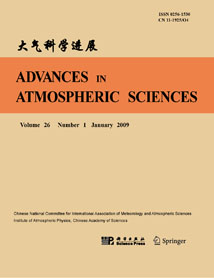| [1] |
Ya GAO, Huijun WANG, Dong CHEN,
2017: Interdecadal Variations of the South Asian Summer Monsoon Circulation Variability and the Associated Sea Surface Temperatures on Interannual Scales, ADVANCES IN ATMOSPHERIC SCIENCES, 34, 816-832.
doi: 10.1007/ s00376-017-6246-8
|
| [2] |
Kairan YING, Jing PENG, Li DAN, Xiaogu ZHENG,
2022: Ocean–atmosphere Teleconnections Play a Key Role in the Interannual Variability of Seasonal Gross Primary Production in China, ADVANCES IN ATMOSPHERIC SCIENCES, 39, 1329-1342.
doi: 10.1007/s00376-021-1226-4
|
| [3] |
Wenjing HUANG, Timothy J. GRIFFIS, Cheng HU, Wei XIAO, Xuhui LEE,
2021: Seasonal Variations of CH4 Emissions in the Yangtze River Delta Region of China Are Driven by Agricultural Activities, ADVANCES IN ATMOSPHERIC SCIENCES, 38, 1537-1551.
doi: 10.1007/s00376-021-0383-9
|
| [4] |
GAO Lijie, ZHANG Meigen, HAN Zhiwei,
2009: Model Analysis of Seasonal Variations in Tropospheric Ozone and Carbon Monoxide over East Asia, ADVANCES IN ATMOSPHERIC SCIENCES, 26, 312-318.
doi: 10.1007/s00376-009-0312-9
|
| [5] |
BIAN Lingen, LIN Xiang,
2012: Interdecadal Change in the Antarctic Circumpolar Wave during 1951--2010, ADVANCES IN ATMOSPHERIC SCIENCES, 29, 464-470.
doi: 10.1007/s00376-011-1143-z
|
| [6] |
ZHOU Botao, WANG Huijun,
2008: Interdecadal Change in the Connection Between Hadley Circulation and Winter Temperature in East Asia, ADVANCES IN ATMOSPHERIC SCIENCES, 25, 24-30.
doi: 10.1007/s00376-008-0024-6
|
| [7] |
NING Liang, QIAN Yongfu,
2009: Interdecadal Change in Extreme Precipitation over South China and Its Mechanism, ADVANCES IN ATMOSPHERIC SCIENCES, 26, 109-118.
doi: 10.1007/s00376-009-0109-x
|
| [8] |
Cen WANG, Baohua REN, Gen LI, Jianqiu ZHENG, Linwei JIANG, Di XU,
2023: An Interdecadal Change in the Influence of the NAO on Atlantic-Induced Arctic Daily Warming around the Mid-1980s, ADVANCES IN ATMOSPHERIC SCIENCES, 40, 1285-1297.
doi: 10.1007/s00376-022-2218-8
|
| [9] |
HAN Jinping, WANG Huijun,
2007: Interdecadal Variability of the East Asian Summer Monsoon in an AGCM, ADVANCES IN ATMOSPHERIC SCIENCES, 24, 808-818.
doi: 10.1007/s00376-007-0808-0
|
| [10] |
Buwen DONG, LU Riyu,
2013: Interdecadal Enhancement of the Walker Circulation over the Tropical Pacific in the Late 1990s, ADVANCES IN ATMOSPHERIC SCIENCES, 30, 247-262.
doi: 10.1007/s00376-012-2069-9
|
| [11] |
Kui LIU, Lian-Tong ZHOU, Zhibiao WANG, Yong LIU,
2023: Interdecadal Enhancement in the Relationship between the Western North Pacific Summer Monsoon and Sea Surface Temperature in the Tropical Central-Western Pacific after the Early 1990s, ADVANCES IN ATMOSPHERIC SCIENCES, 40, 1766-1782.
doi: 10.1007/s00376-023-2200-0
|
| [12] |
CHEN Wen, ZHOU Qun,
2012: Modulation of the Arctic Oscillation and the East Asian Winter Climate Relationships by the 11-year Solar Cycle, ADVANCES IN ATMOSPHERIC SCIENCES, 29, 217-226.
doi: 10.1007/s00376-011-1095-3
|
| [13] |
WEI Ke, BAO Qing,
2012: Projections of the East Asian Winter Monsoon under the IPCC AR5 Scenarios Using a Coupled Model: IAP-FGOALS, ADVANCES IN ATMOSPHERIC SCIENCES, 29, 1200-1214.
doi: 10.1007/s00376-012-1226-5
|
| [14] |
CHEN Shangfeng, CHEN Wen, WEI Ke,
2013: Recent Trends in Winter Temperature Extremes in Eastern China and their Relationship with the Arctic Oscillation and ENSO, ADVANCES IN ATMOSPHERIC SCIENCES, 30, 1712-1724.
doi: 10.1007/s00376-013-2296-8
|
| [15] |
Shi Neng, Chen Luwen, Xia Dongdong,
2002: A Preliminary Study on the Global Land Annual Precipitation Associated with ENSO during 1948-2000, ADVANCES IN ATMOSPHERIC SCIENCES, 19, 993-1003.
doi: 10.1007/s00376-002-0060-6
|
| [16] |
Kaiming HU, Yingxue LIU, Gang HUANG, Zhuoqi HE, Shang-Min LONG,
2020: Contributions to the Interannual Summer Rainfall Variability in the Mountainous Area of Central China and Their Decadal Changes, ADVANCES IN ATMOSPHERIC SCIENCES, 37, 259-268.
doi: 10.1007/s00376-019-9099-5
|
| [17] |
Peng HU, Wen CHEN, Shangfeng CHEN, Lin WANG, Yuyun LIU,
2022: The Weakening Relationship between ENSO and the South China Sea Summer Monsoon Onset in Recent Decades, ADVANCES IN ATMOSPHERIC SCIENCES, 39, 443-455.
doi: 10.1007/s00376-021-1208-6
|
| [18] |
Zhiwei ZHU, Rui LU, Shanshan FU, Hua CHEN,
2023: Alternation of the Atmospheric Teleconnections Associated with the Northeast China Spring Rainfall during a Recent 60-Year Period, ADVANCES IN ATMOSPHERIC SCIENCES, 40, 168-176.
doi: 10.1007/s00376-022-2024-3
|
| [19] |
Chujie Gao, Yuyu Niu, Gen Li, Shanlei Sun, Bo Lu, Chaofan Li, Bei Xu, Jinglong Huang, Xiubao Sun,
2024: Enhancing effect of East Asian subtropical westerly jet on summer extreme high temperature events over central-eastern China, ADVANCES IN ATMOSPHERIC SCIENCES.
doi: 10.1007/s00376-024-4027-8
|
| [20] |
Hai ZHI, Zihui YANG, Rong-Hua ZHANG, Pengfei LIN, Jifeng QI, Yu HUANG, Meng DONG,
2023: Asymmetry of Salinity Variability in the Tropical Pacific during Interdecadal Pacific Oscillation Phases, ADVANCES IN ATMOSPHERIC SCIENCES, 40, 1269-1284.
doi: 10.1007/s00376-022-2284-y
|















 AAS Website
AAS Website 
 AAS WeChat
AAS WeChat 
 DownLoad:
DownLoad: